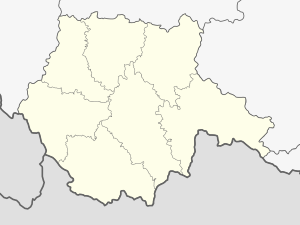Hus Castle
| Hus Castle | ||
|---|---|---|
|
Remains of the castle |
||
| Alternative name (s): | Castle goose | |
| Creation time : | 1341 | |
| Castle type : | Höhenburg, spur location | |
| Conservation status: | ruin | |
| Place: | Blažejovice | |
| Geographical location | 48 ° 57 '25 " N , 13 ° 55' 44" E | |
| Height: | 720 m nm | |
|
|
||
The ruins of Hus Castle (German Castle Gans ) are located in the foothills of the Bohemian Forest , two kilometers west of the Blažejovice district in the area of the municipality of Zbytiny in Okres Prachatice ( Czech Republic ).
geography
The Burgruine the spur Burg located at the south foot of Panský vrch (834 m) from the Wüstung Cudrovice ( Zuderschlag ) on the narrow from the Blanice reflowed wooded Felssporn Na husí .
Surrounding villages are Křišťanovice in the northeast, Blanický Mlýn and Blažejovice in the east, Můstek in the southeast, Chalupy na Blatech in the west and Mlynářovice and Plešivec in the northwest.
history
In 1341, the Bohemian King John of Luxembourg approved the brothers Jenšík, Vavřinec and Pešek von Janovice at Vimperk Castle to build a protective castle on the goose ( montem vulgariter dictum uf der Gans ) for their newly founded villages around Záblatí . Because of its location above the Goldener Steig between Volary and Prachatice , it also served as a watch castle, whereby the king reserved free access to the castle in the event of a threat of invasion by enemy troops from Bavaria. In 1359, Charles IV confirmed to Pešek von Janovice that he owned the Gans castrum with its 23 villages, including the towns of Husinec and Záblatí and the villages of Křišťanovice, Lažiště , Milešice, Mlynářovice, Řepešín, Zábrdí and Zvěřinec. In 1361 the castle was first mentioned under the Czech name Huscz . After 1363 the sex of Janovice in the male line died out, the rule goose fell into royal estate home . Around 1390 King Wenceslas IV left the rule to his favorite Siegmund Huller von Worlik ( Zikmund Huler z Orlíka ). His rise to the sub-chamberlain of the Kingdom of Bohemia ended in 1394 by impeachment for embezzlement and confiscation of his property; he was executed in 1405. In 1399, Wenceslaus IV appointed Nikolaus von Pistny as Burgrave von Gans, who from 1404 acquired the title de Huss . During the conflict over the teaching of Jan Hus , Nikolaus von Hus openly advocated his teaching and was banished from Prague in 1419 after he had spoken out in favor of admitting communion under both guises . After the outbreak of the Hussite Wars , Nikolaus von Hus and Čichtitz became one of the leading captains of the Taborites and defeated the royal troops under Ulrich von Rosenberg during the First Crusade near Tábor in 1420 . Nikolaus von Hus died on Christmas Eve 1420 in Prague following a fall from his horse. The subsequent owner of the estate was the knight Jan Smil von Krems , who fought numerous feuds with Ulrich von Rosenberg. In 1439 Jan Smil accepted Ulrich von Rosenberg's invitation to negotiate at Krumau Castle , where he was captured. Subsequently, the robber baron Habart Lopata von Hrádek seized the orphaned castle and used it as a hiding place for his attacks on merchants passing through on the Goldener Steig. In 1441 Přibík von Klenová , Peter Zmrzlík von Schweising and Jan Sedlecký von Prachatice besieged Hus Castle; they eventually took it and burned it down. Although Jan Smil von Krems left his possessions to Ulrich von Rosenberg in July 1444, he was executed in Krumau in 1447. The castle was never rebuilt and its remains were left to decay.
investment
Hus Castle consisted of an inner castle and outer castle separated by moats . Overgrown remains of two ditches and the walls have been preserved in the high forest. A marked hiking trail leads from the cemetery in the desert of Cudrovice to the ruins.
Web links
- Description on hrady.cz , accessed February 6, 2016
- Description on castles.cz , accessed February 6, 2016
- Description on vestinu.cz , accessed February 6, 2016
- About the origin of the name (PDF; 49 kB), accessed February 6, 2016
- Franz Alexander Heber , Boehmens Burgen, Vesten und Bergschlösser , Volume 2, Prague 1844, pages 82-88 , accessed February 6, 2016

